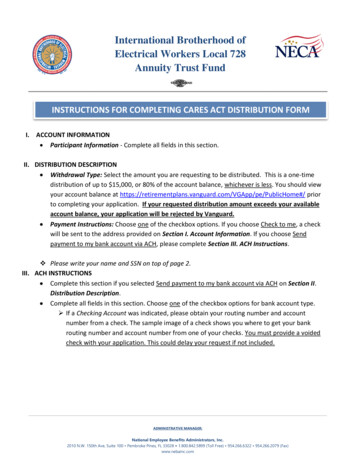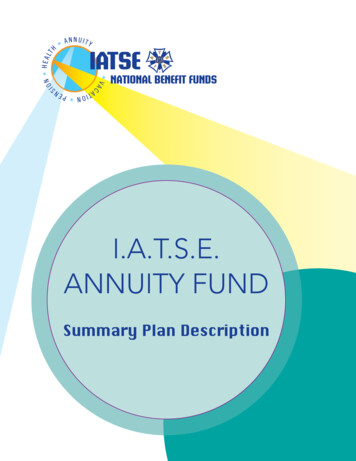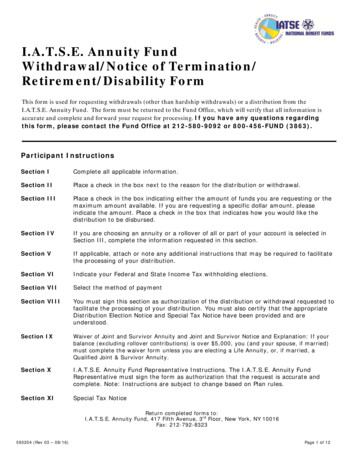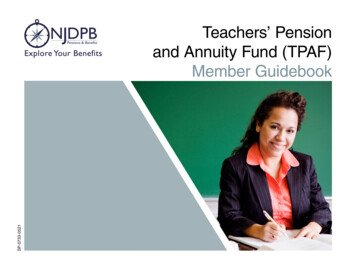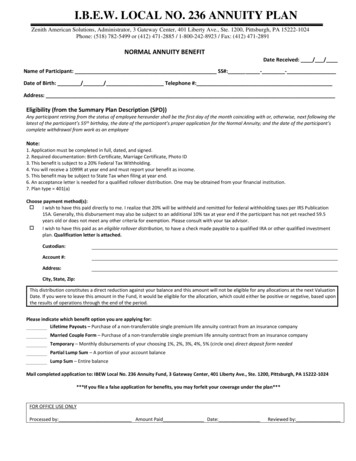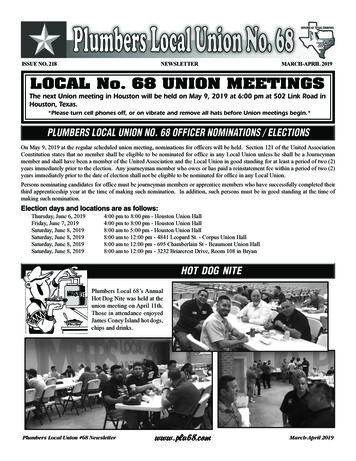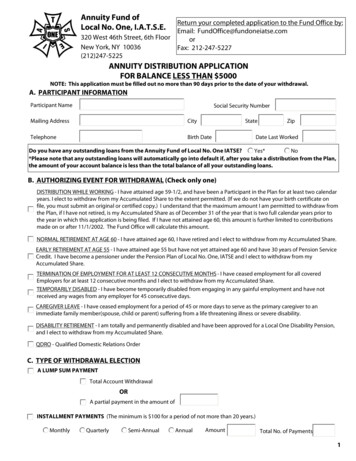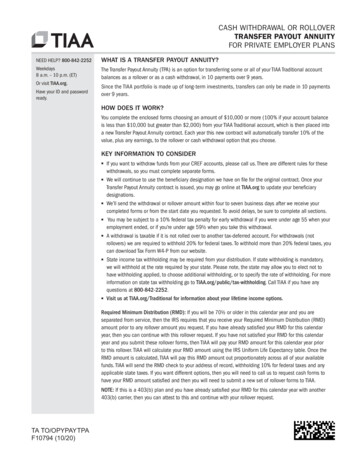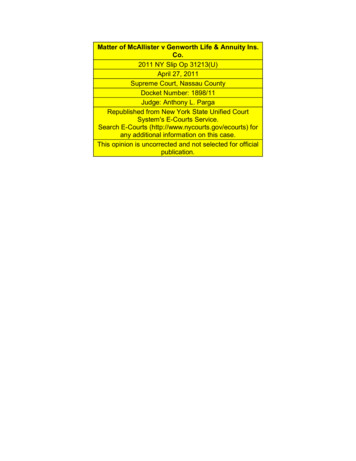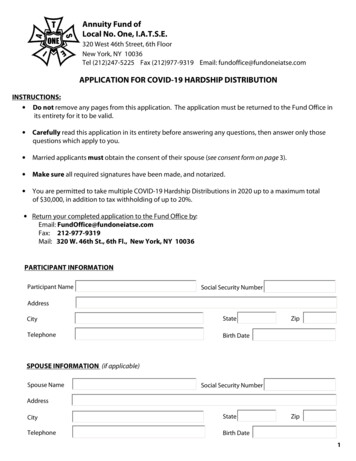
Transcription
Annuity Fund ofLocal No. One, I.A.T.S.E.320 West 46th Street, 6th FloorNew York, NY 10036Tel (212)247-5225 Fax (212)977-9319 Email: fundoffice@fundoneiatse.comAPPLICATION FOR COVID-19 HARDSHIP DISTRIBUTIONINSTRUCTIONS: Do not remove any pages from this application. The application must be returned to the Fund Office inits entirety for it to be valid. Carefully read this application in its entirety before answering any questions, then answer only thosequestions which apply to you. Married applicants must obtain the consent of their spouse (see consent form on page 3). Make sure all required signatures have been made, and notarized. You are permitted to take multiple COVID-19 Hardship Distributions in 2020 up to a maximum totalof 30,000, in addition to tax withholding of up to 20%. Return your completed application to the Fund Office by:Email: FundOffice@fundoneiatse.comFax: 212-977-9319Mail: 320 W. 46th St., 6th Fl., New York, NY 10036PARTICIPANT INFORMATIONParticipant NameSocial Security NumberAddressCityStateTelephoneBirth DateZipSPOUSE INFORMATION (if applicable)Spouse NameSocial Security NumberAddressCityStateTelephoneBirth DateZip1
STATEMENT OF MARITAL STATUS (check and complete only one)1.NOT MARRIEDI hereby freely state that I am not legally married at the present time.*Participant SignatureDatePrint Participant Name*Please Note: Your signature must be signed in the presence of a Notary PublicNotary PublicSTATE OFCOUNTY OFSS:On the day of , 20 , before me came ,to me known and known to me to be the person described above who executed the foregoing statement beforeme under oath.Notary Public2.MARRIED (your spouse must complete the consent form on the following page)I hereby freely state that I am legally married to(Print Name of Spouse)the person co-signing this document.*Participant Signaturewho I hereby certify to beDatePrint Participant Name*Please Note: Your signature must be signed in the presence of a Notary PublicNotary PublicSTATE OFCOUNTY OFSS:On the day of , 20 , before me came ,to me known and known to me to be the person described above who executed the foregoing statement beforeme under oath.Notary Public2
COVID-19 Hardship DistributionExpenses and losses (including loss of income due to closures and layoffs) incurred by theParticipant on account of the COVID-19 virus, regardless of whether the Participant was infected,quarantined or otherwise isolated.Amount Requested (after tax withholding)SPOUSE'S STATEMENT OF CONSENTI,swear that I am the legal spouse of the Participant described(Print Your Name)herein and hereby consent to my spouse's application for a COVID-19 Hardship Distribution described above.I also state my understanding that, as a result of this Distribution, any survivor's benefits due me from the AnnuityFund of Local No. One, I.A.T.S.E. after my spouse's death will be reduced as a result of this distribution.*Spouse SignatureDatePrint Spouse Name*Please Note: Your signature must be signed in the presence of a Notary PublicNotary PublicSTATE OFCOUNTY OFSS:On the day of , 20 , before me came ,to me known and known to me to be the person described above who executed the foregoing statement beforeme under oath.Notary Public3
VOLUNTARY FEDERAL TAX WITHHOLDINGI understand that the Internal Revenue Code permits me to elect whether or not any Federal Income Tax (in addition tothe mandatory withholding rate of 10% if required) should be withheld from this COVID-19 Hardship Distribution.I further understand that whatever my election, I may still be liable for payment of Federal Income Tax on the taxableportion of this COVID-19 Hardship Distribution. In addition, I understand I could be subject to tax penalties under theestimated payment rules if the payment of estimate taxes and withholding are not adequate.I only want to have the 10% mandatory Federal Income Tax withheld from my COVID-19 Hardship Distribution.I want to withhold more than 10%. Please withhold the following amount from my distribution for taxes.Total Withholding Percentage%PARTICIPANT CERTIFICATIONI hereby freely state that I have read and understand all the information provided in this Application. I certifythat I have incurred expenses and losses (which may include loss of income due to closures and layoffs) as aresult of the COVID-19 virus. I also certify that all the statements I have made in this Application are true andaccurate to the best of my knowledge. In addition, I agree to be bound by all the rules and regulations of theAnnuity Fund of Local No. One, IATSE.Participant SignatureDatePrint Participant Name*Please Note: Your signature must be signed in the presence of a Notary PublicNotary PublicSTATE OFCOUNTY OFSS:On the day of , 20 , before me came ,to me known and known to me to be the person described above who executed the foregoing statement beforeme under oath.Notary Public4
METHOD OF PAYMENT TO PARTICIPANTCheckORDirect Deposit (Please complete the Annuity Direct Deposit Agreement below)ANNUITY DIRECT DEPOSIT AGREEMENTAccount Number:51631-1-1Sponsor Name:Plan:Annuity Fund of Local No. One IATSEAnnuity Fund of Local No. One IATSEPARTICIPANT INFORMATIONSocial Security NumberParticipant NameMailing AddressCityTelephoneStateZipEmail AddressAUTHORIZATIONI authorize MassMutual to make all retirement payments due to me under the above-numbered account by Electronic DirectDeposit to the bank account designated below. I also authorize MassMutual to initiate debits to that bank account foroverpayment made to me and the bank named below to debit my account and refund any such overpayment to them.Payments made under this agreement fully satisfy any obligation to make payments to me.I also agree that, to cancel this agreement, I must give at least one month's written notice to MassMutual's Home Office. Uponmy death, my executors or administrators will pay to MassMutual from my estate the amount of any payments collected by theBank which may have been considered as an overpayment depending upon the type of distribution election i made.By electing direct deposit and by signing this form, I certify that I am an account holder on the bank account listed below.Bank NameTelephoneBank AddressCityStateZipBank Transit Routing #Bank Account #Type of Account:Checking (attach a copy of a voided check)Savings (attach a savings deposit slip)To help protect our customers' assets, MassMutual will independently validate bank and customer account information beforeprocessing Direct Deposit /EFT. If we are unable to independently validate the bank and customer account information orsufficient documentation to support the Direct Deposit/EFT is not provided, we will mail a check to the address of record. Itshould be noted that we are not always able to independently validate credit unions or smaller banks.SIGNATUREParticipant SignatureDate5
Local No. One, I.A.T.S.E. Annuity FundYOUR ROLLOVER OPTIONSYou are receiving this notice because all or a portion of a payment you are receiving from the Local No. One,I.A.T.S.E. Annuity Fund (the “Plan”) is eligible to be rolled over to an IRA or an employer plan. This noticedescribes the rollover rules that apply to payments from the Plan and is intended to help you decide whether to dosuch a rollover.Rules that apply to most payments from a plan are described in the “General Information About Rollovers”section. Special rules that only apply in certain circumstances are described in the “Special Rules and Options”section.GENERAL INFORMATION ABOUT ROLLOVERSHow can a rollover affect my taxes?You will be taxed on a payment from the Plan if you do not roll it over. If you are under age 59½ and do not do arollover, you will also have to pay a 10% additional income tax on early distributions (generally, distributionsmade before age 59½), unless an exception applies. However, if you do a rollover, you will not have to pay taxuntil you receive payments later and the 10% additional income tax will not apply if those payments are madeafter you are age 59½ (or if an exception applies).What types of retirement accounts and plans accept my rollover?You may roll over the payment to either an IRA (an individual retirement account or individual retirementannuity) or an employer plan (a tax-qualified plan, section 403(b) plan, or governmental section 457(b) plan) thatwill accept the rollover. The rules of the IRA or employer plan that receives the rollover will determine yourinvestment options, fees, and rights to payment from the IRA or employer plan (for example, no spousal consentrules apply to IRAs and IRAs may not provide loans). Further, the amount rolled over will become subject to thetax rules that apply to the IRA or employer plan.How do I do a rollover?There are two ways to do a rollover. You can do either a direct rollover or a 60-day rollover.If you do a direct rollover, the Plan will make the payment directly to your IRA or an employer plan. You shouldcontact the IRA sponsor or the administrator of the employer plan for information on how to do a direct rollover.If you do not do a direct rollover, you may still do a rollover by making a deposit into an IRA or eligibleemployer plan that will accept it. Generally, you will have 60 days after you receive the payment to make thedeposit. If you do not do a direct rollover, the Plan is required to withhold 20% of the payment for federalincome taxes. This means that, in order to roll over the entire payment in a 60-day rollover, you must use otherfunds to make up for the 20% withheld. If you do not roll over the entire amount of the payment, the portion notrolled over will be taxed and will be subject to the 10% additional income tax on early distributions if you areunder age 59½ (unless an exception applies).
How much may I roll over?If you wish to do a rollover, you may roll over all or part of the amount eligible for rollover. Any payment fromthe Plan is eligible for rollover, except:§ Certain payments spread over a period of at least 10 years or over your life or life expectancy (or thelives or joint life expectancy of you and your beneficiary)§ Required minimum distributions after age 70½ (or after death)§ Hardship distributions§ Corrective distributions of contributions that exceed tax law limitations§ Loans treated as deemed distributions (for example, loans in default due to missed payments beforeyour employment ends)The Plan administrator or the payor can tell you what portion of a payment is eligible for rollover.If I don't do a rollover, will I have to pay the 10% additional income tax on early distributions?If you are under age 59½, you will have to pay the 10% additional income tax on early distributions for anypayment from the Plan (including amounts withheld for income tax) that you do not roll over, unless one of theexceptions listed below applies. This tax applies to the part of the distribution that you must include in incomeand is in addition to the regular income tax on the payment not rolled over.The 10% additional income tax does not apply to the following payments from the Plan:§ Payments made after you separate from service if you will be at least age 55 in the year of theseparation§ Payments that start after you separate from service if paid at least annually in equal or close to equalamounts over your life or life expectancy (or the lives or joint life expectancy of you and yourbeneficiary)§ Payments made due to disability§ Payments after your death§ Corrective distributions of contributions that exceed tax law limitations§ Payments made directly to the government to satisfy a federal tax levy§ Payments made under a qualified domestic relations order (QDRO)§ Certain payments made while you are on active duty if you were a member of a reserve component calledto duty after September 11, 2001 for more than 179 days§ Payments made for certain distributions relating to certain federally declared disasters
If I do a rollover to an IRA, will the 10% additional income tax apply to early distributions from the IRA?If you receive a payment from an IRA when you are under age 59½, you will have to pay the 10% additionalincome tax on early distributions on the part of the distribution that you must include in income, unless anexception applies. In general, the exceptions to the 10% additional income tax for early distributions from anIRA are the same as the exceptions listed above for early distributions from a plan. However, there are a fewdifferences for payments from an IRA, including:§ The exception for payments made after you separate from service if you will be at least age 55 in the yearof the separation does not apply.§ The exception for qualified domestic relations orders (QDROs) does not apply (although a special ruleapplies under which, as part of a divorce or separation agreement, a tax-free transfer may be madedirectly to an IRA of a spouse or former spouse).§ The exception for payments made at least annually in equal or close to equal amounts over a specifiedperiod applies without regard to whether you have had a separation from service.§ There are additional exceptions for (1) payments for qualified higher education expenses, (2) paymentsup to 10,000 used in a qualified first-time home purchase, and (3) payments for health insurancepremiums after you have received unemployment compensation for 12 consecutive weeks (or would havebeen eligible to receive unemployment compensation but for self-employed status).Will I owe State income taxes?This notice does not describe any State or local income tax rules (including withholding rules).SPECIAL RULES AND OPTIONSIf you miss the 60-day rollover deadlineGenerally, the 60-day rollover deadline cannot be extended. However, the IRS has the limited authority to waivethe deadline under certain extraordinary circumstances, such as when external events prevented you fromcompleting the rollover by the 60-day rollover deadline. Under certain circumstances, you may claim eligibilityfor a waiver of the 60-day rollover deadline by making a written self-certification. Otherwise, to apply for awaiver from the IRS, you must file a private letter ruling request with the IRS. Private letter ruling requestsrequire the payment of a nonrefundable user fee. For more information, see IRS Publication 590-A,Contributions to Individual Retirement Arrangements (IRAs).If you have an outstanding loan that is being offsetIf you have an outstanding loan from the Plan, your Plan benefit may be offset by the outstanding amount of theloan, typically when your employment ends. The offset amount is treated as a distribution to you at the time ofthe offset. Generally, you may roll over all or any portion of the offset amount. Any offset amount that is notrolled over will be taxed (including the 10% additional income tax on early distributions, unless an exceptionapplies). You may roll over offset amounts to an IRA or an employer plan (if the terms of the employer planpermit the plan to receive plan loan offset rollovers).
How long you have to complete the rollover depends on what kind of plan loan offset you have. If you have aqualified plan loan offset, you will have until your tax return due date (including extensions) for the tax yearduring which the offset occurs to complete your rollover. A qualified plan loan offset occurs when a plan loanin good standing is offset because your employer plan terminates, or because you sever from employment. Ifyour plan loan offset occurs for any other reason, then you have 60 days from the date the offset occurs tocomplete your rollover.If you were born on or before January 1, 1936If you were born on or before January 1, 1936 and receive a lump sum distribution that you do not roll over,special rules for calculating the amount of the tax on the payment might apply to you. For more information,see IRS Publication 575, Pension and Annuity Income.If you roll over your payment to a Roth IRAIf you roll over the payment from the Plan to a Roth IRA, a special rule applies under which the amount of thepayment rolled over will be taxed. However, the 10% additional income tax on early distributions will notapply (unless you take the amount rolled over out of the Roth IRA within 5 years, counting from January 1 ofthe year of the rollover).If you roll over the payment to a Roth IRA, later payments from the Roth IRA that are qualified distributionswill not be taxed (including earnings after the rollover). A qualified distribution from a Roth IRA is a paymentmade after you are age 59½ (or after your death or disability, or as a qualified first-time homebuyer distributionof up to 10,000) and after you have had a Roth IRA for at least 5 years. In applying this 5-year rule, youcount from January 1 of the year for which your first contribution was made to a Roth IRA. Payments from theRoth IRA that are not qualified distributions will be taxed to the extent of earnings after the rollover, includingthe 10% additional income tax on early distributions (unless an exception applies). You do not have to takerequired minimum distributions from a Roth IRA during your lifetime. For more information, see IRSPublication 590-A, Contributions to Individual Retirement Arrangements (IRAs), and IRS Publication 590-B,Distributions from Individual Retirement Arrangements (IRAs).You cannot roll over a payment from the Plan to a designated Roth account in an employer plan.If you are not a Plan participantPayments after death of the participant. If you receive a distribution after the participant's death that you do notroll over, the distribution will generally be taxed in the same manner described elsewhere in this notice.However, the 10% additional income tax on early distributions does not apply, and the special rule describedunder the section “If you were born on or before January 1, 1936” applies only if the participant was born on orbefore January 1, 1936.If you are a surviving spouse. If you receive a payment from the Plan as the surviving spouse of adeceased participant, you have the same rollover options that the participant would have had, asdescribed elsewhere in this notice. In addition, if you choose to do a rollover to an IRA, you may treatthe IRA as your own or as an inherited IRA.An IRA you treat as your own is treated like any other IRA of yours, so that payments made to youbefore you are age 59½ will be subject to the 10% additional income tax on early distributions (unlessan exception applies) and required minimum distributions from your IRA do not have to start until afteryou are age 70½.
If you treat the IRA as an inherited IRA, payments from the IRA will not be subject to the 10%additional income tax on early distributions. However, if the participant had started taking requiredminimum distributions, you will have to receive required minimum distributions from the inheritedIRA. If the participant had not started taking required minimum distributions from the Plan, you willnot have to start receiving required minimum distributions from the inherited IRA until the year theparticipant would have been age 70½.If you are a surviving beneficiary other than a spouse. If you receive a payment from the Planbecause of the participant's death and you are a designated beneficiary other than a surviving spouse, theonly rollover option you have is to do a direct rollover to an inherited IRA. Payments from theinherited IRA will not be subject to the 10% additional income tax on early distributions. You will haveto receive required minimum distributions from the inherited IRA.Payments under a qualified domestic relations order. If you are the spouse or former spouse of the participantwho receives a payment from the Plan under a qualified domestic relations order (QDRO), you generally have
Annuity Fund of Local No. One, I.A.T.S.E. 320 West 46th Street, 6th Floor New York, NY 10036 Tel (212)247-5225 Fax (212)977-9319 Email: fundoffice@fundoneiatse.com. APPLICATION FOR COVID-19 HARDSHIP DISTRIBUTION. PARTICIPANT INFORMATION. 1. Participant Name Social Security Nu
